Servant Leadership: Transformational Leadership and Business Growth
VerifiedAdded on 2020/04/29
|14
|4078
|112
Essay
AI Summary
This essay provides a comprehensive literature review on servant leadership, examining its profound impact on employee satisfaction, organizational effectiveness, and business development. It delves into the core tenets of servant leadership, highlighting its emphasis on intrinsic motivation, employee development, and the creation of a supportive work environment. The essay explores the importance of transformational leadership, emphasizing its role in fostering innovation, creativity, and a shared vision within organizations. It contrasts servant leadership with transactional leadership, showcasing the former's advantages in promoting corporate learning, reducing employee turnover, and building strong coalitions. Furthermore, the essay identifies key attributes of transformational leaders, including individualized consideration, creativity, team orientation, and effective communication skills. Through this analysis, the essay underscores the significance of servant leadership in cultivating a positive and productive work environment, ultimately contributing to enhanced organizational performance and employee well-being. The essay also points out the importance of traits like individualized consideration, creativity, team orientation, and appreciation of others for servant leaders.

Running head: SERVANT LEADERSHIP
SERVANT LEADERSHIP
Name of the student:
Name of the university:
Author note:
SERVANT LEADERSHIP
Name of the student:
Name of the university:
Author note:
Paraphrase This Document
Need a fresh take? Get an instant paraphrase of this document with our AI Paraphraser
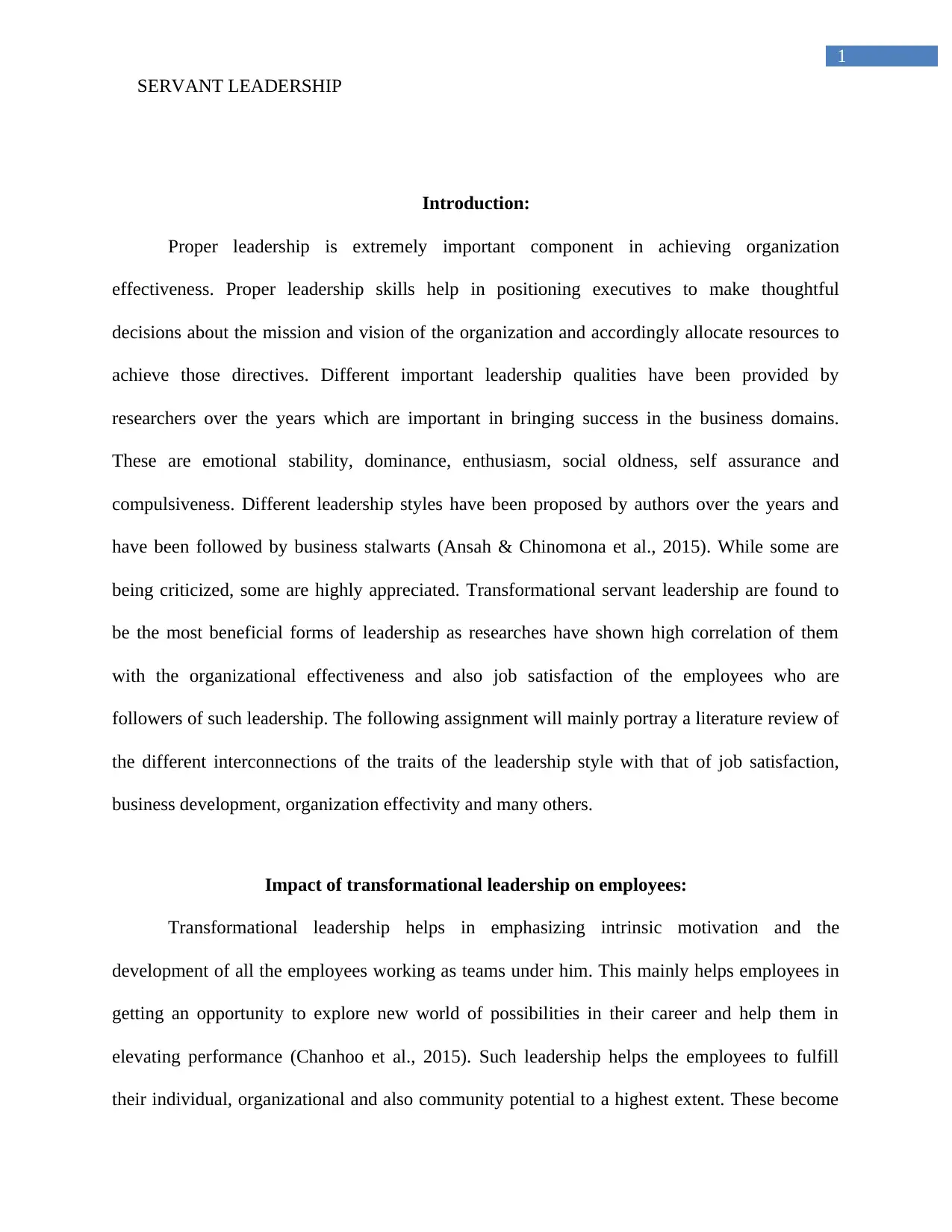
1
SERVANT LEADERSHIP
Introduction:
Proper leadership is extremely important component in achieving organization
effectiveness. Proper leadership skills help in positioning executives to make thoughtful
decisions about the mission and vision of the organization and accordingly allocate resources to
achieve those directives. Different important leadership qualities have been provided by
researchers over the years which are important in bringing success in the business domains.
These are emotional stability, dominance, enthusiasm, social oldness, self assurance and
compulsiveness. Different leadership styles have been proposed by authors over the years and
have been followed by business stalwarts (Ansah & Chinomona et al., 2015). While some are
being criticized, some are highly appreciated. Transformational servant leadership are found to
be the most beneficial forms of leadership as researches have shown high correlation of them
with the organizational effectiveness and also job satisfaction of the employees who are
followers of such leadership. The following assignment will mainly portray a literature review of
the different interconnections of the traits of the leadership style with that of job satisfaction,
business development, organization effectivity and many others.
Impact of transformational leadership on employees:
Transformational leadership helps in emphasizing intrinsic motivation and the
development of all the employees working as teams under him. This mainly helps employees in
getting an opportunity to explore new world of possibilities in their career and help them in
elevating performance (Chanhoo et al., 2015). Such leadership helps the employees to fulfill
their individual, organizational and also community potential to a highest extent. These become
SERVANT LEADERSHIP
Introduction:
Proper leadership is extremely important component in achieving organization
effectiveness. Proper leadership skills help in positioning executives to make thoughtful
decisions about the mission and vision of the organization and accordingly allocate resources to
achieve those directives. Different important leadership qualities have been provided by
researchers over the years which are important in bringing success in the business domains.
These are emotional stability, dominance, enthusiasm, social oldness, self assurance and
compulsiveness. Different leadership styles have been proposed by authors over the years and
have been followed by business stalwarts (Ansah & Chinomona et al., 2015). While some are
being criticized, some are highly appreciated. Transformational servant leadership are found to
be the most beneficial forms of leadership as researches have shown high correlation of them
with the organizational effectiveness and also job satisfaction of the employees who are
followers of such leadership. The following assignment will mainly portray a literature review of
the different interconnections of the traits of the leadership style with that of job satisfaction,
business development, organization effectivity and many others.
Impact of transformational leadership on employees:
Transformational leadership helps in emphasizing intrinsic motivation and the
development of all the employees working as teams under him. This mainly helps employees in
getting an opportunity to explore new world of possibilities in their career and help them in
elevating performance (Chanhoo et al., 2015). Such leadership helps the employees to fulfill
their individual, organizational and also community potential to a highest extent. These become
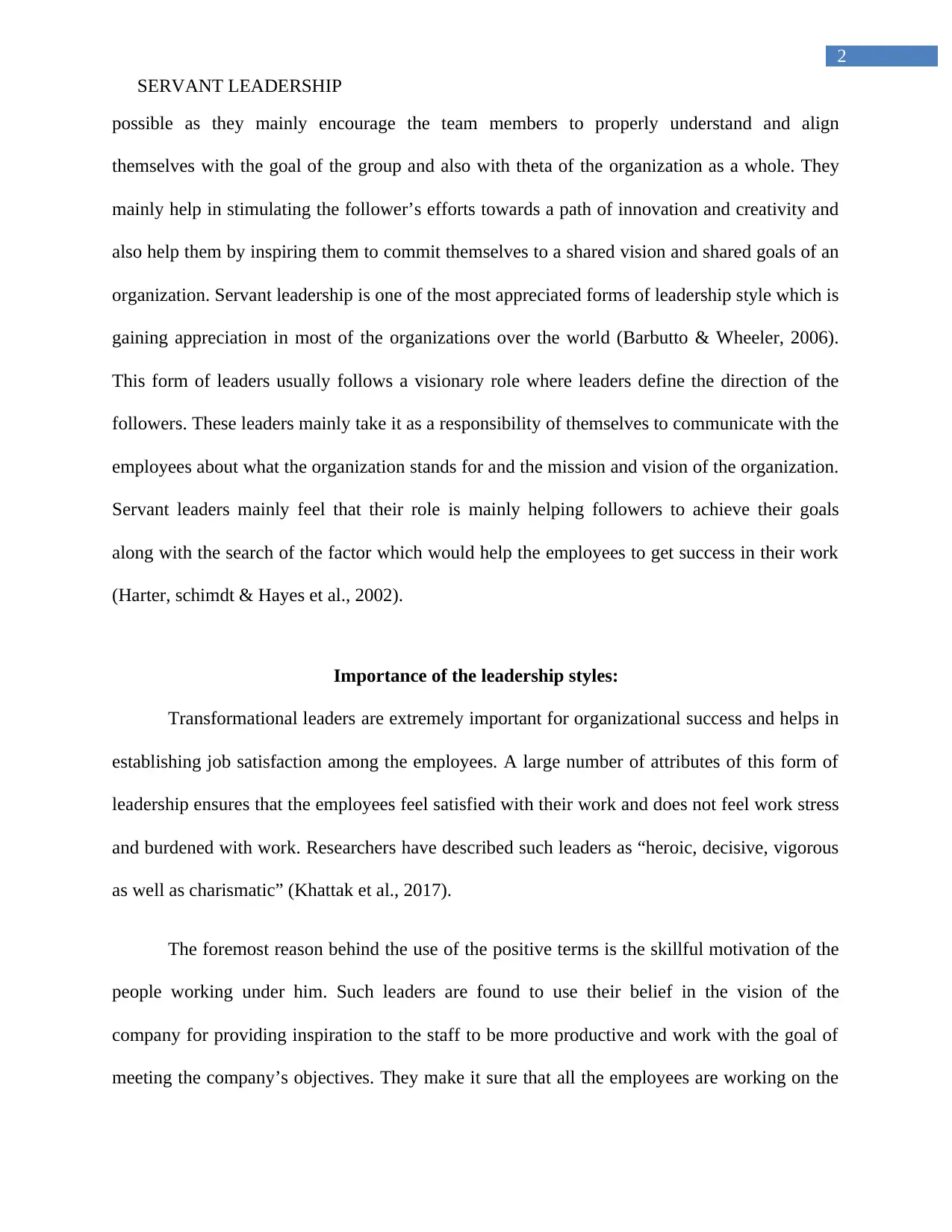
2
SERVANT LEADERSHIP
possible as they mainly encourage the team members to properly understand and align
themselves with the goal of the group and also with theta of the organization as a whole. They
mainly help in stimulating the follower’s efforts towards a path of innovation and creativity and
also help them by inspiring them to commit themselves to a shared vision and shared goals of an
organization. Servant leadership is one of the most appreciated forms of leadership style which is
gaining appreciation in most of the organizations over the world (Barbutto & Wheeler, 2006).
This form of leaders usually follows a visionary role where leaders define the direction of the
followers. These leaders mainly take it as a responsibility of themselves to communicate with the
employees about what the organization stands for and the mission and vision of the organization.
Servant leaders mainly feel that their role is mainly helping followers to achieve their goals
along with the search of the factor which would help the employees to get success in their work
(Harter, schimdt & Hayes et al., 2002).
Importance of the leadership styles:
Transformational leaders are extremely important for organizational success and helps in
establishing job satisfaction among the employees. A large number of attributes of this form of
leadership ensures that the employees feel satisfied with their work and does not feel work stress
and burdened with work. Researchers have described such leaders as “heroic, decisive, vigorous
as well as charismatic” (Khattak et al., 2017).
The foremost reason behind the use of the positive terms is the skillful motivation of the
people working under him. Such leaders are found to use their belief in the vision of the
company for providing inspiration to the staff to be more productive and work with the goal of
meeting the company’s objectives. They make it sure that all the employees are working on the
SERVANT LEADERSHIP
possible as they mainly encourage the team members to properly understand and align
themselves with the goal of the group and also with theta of the organization as a whole. They
mainly help in stimulating the follower’s efforts towards a path of innovation and creativity and
also help them by inspiring them to commit themselves to a shared vision and shared goals of an
organization. Servant leadership is one of the most appreciated forms of leadership style which is
gaining appreciation in most of the organizations over the world (Barbutto & Wheeler, 2006).
This form of leaders usually follows a visionary role where leaders define the direction of the
followers. These leaders mainly take it as a responsibility of themselves to communicate with the
employees about what the organization stands for and the mission and vision of the organization.
Servant leaders mainly feel that their role is mainly helping followers to achieve their goals
along with the search of the factor which would help the employees to get success in their work
(Harter, schimdt & Hayes et al., 2002).
Importance of the leadership styles:
Transformational leaders are extremely important for organizational success and helps in
establishing job satisfaction among the employees. A large number of attributes of this form of
leadership ensures that the employees feel satisfied with their work and does not feel work stress
and burdened with work. Researchers have described such leaders as “heroic, decisive, vigorous
as well as charismatic” (Khattak et al., 2017).
The foremost reason behind the use of the positive terms is the skillful motivation of the
people working under him. Such leaders are found to use their belief in the vision of the
company for providing inspiration to the staff to be more productive and work with the goal of
meeting the company’s objectives. They make it sure that all the employees are working on the
⊘ This is a preview!⊘
Do you want full access?
Subscribe today to unlock all pages.

Trusted by 1+ million students worldwide
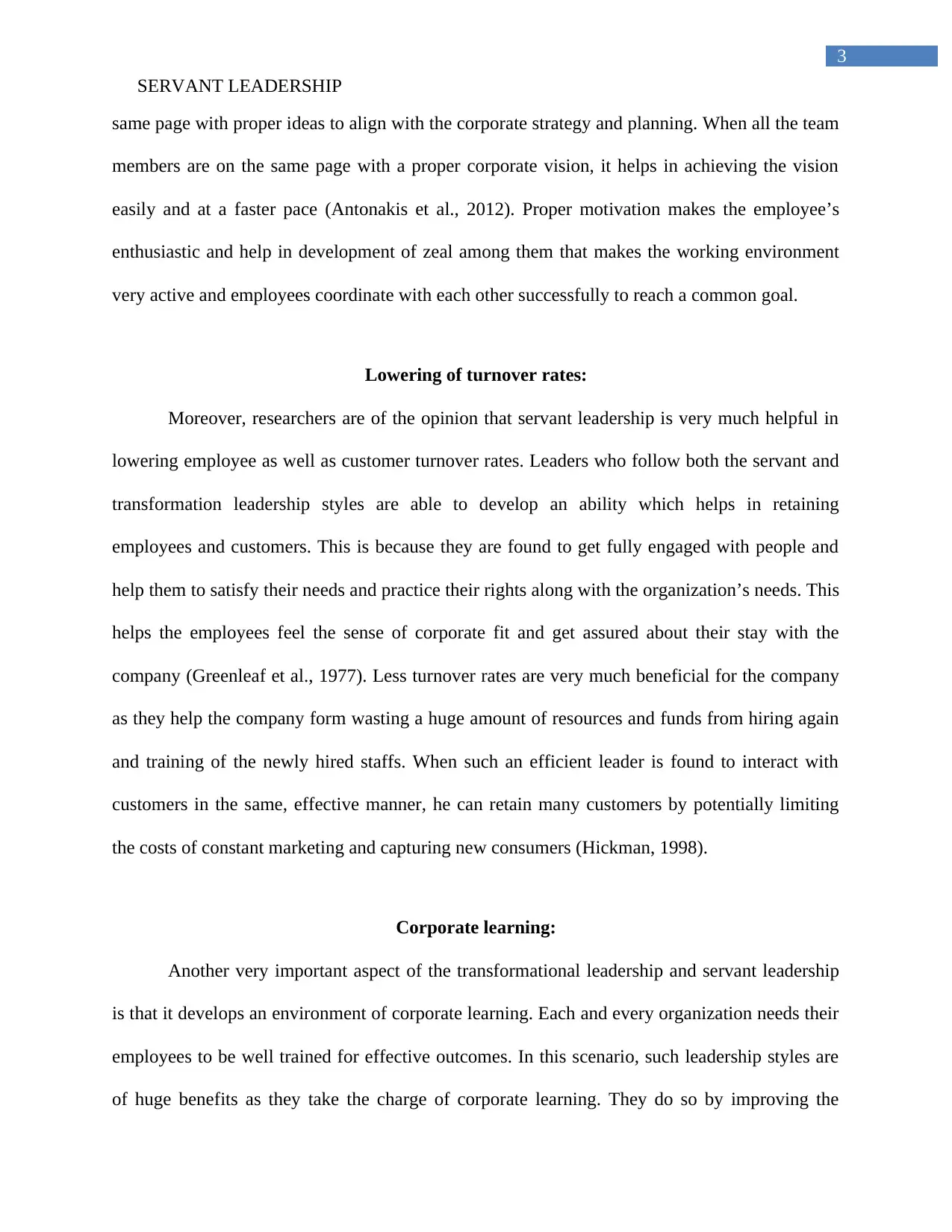
3
SERVANT LEADERSHIP
same page with proper ideas to align with the corporate strategy and planning. When all the team
members are on the same page with a proper corporate vision, it helps in achieving the vision
easily and at a faster pace (Antonakis et al., 2012). Proper motivation makes the employee’s
enthusiastic and help in development of zeal among them that makes the working environment
very active and employees coordinate with each other successfully to reach a common goal.
Lowering of turnover rates:
Moreover, researchers are of the opinion that servant leadership is very much helpful in
lowering employee as well as customer turnover rates. Leaders who follow both the servant and
transformation leadership styles are able to develop an ability which helps in retaining
employees and customers. This is because they are found to get fully engaged with people and
help them to satisfy their needs and practice their rights along with the organization’s needs. This
helps the employees feel the sense of corporate fit and get assured about their stay with the
company (Greenleaf et al., 1977). Less turnover rates are very much beneficial for the company
as they help the company form wasting a huge amount of resources and funds from hiring again
and training of the newly hired staffs. When such an efficient leader is found to interact with
customers in the same, effective manner, he can retain many customers by potentially limiting
the costs of constant marketing and capturing new consumers (Hickman, 1998).
Corporate learning:
Another very important aspect of the transformational leadership and servant leadership
is that it develops an environment of corporate learning. Each and every organization needs their
employees to be well trained for effective outcomes. In this scenario, such leadership styles are
of huge benefits as they take the charge of corporate learning. They do so by improving the
SERVANT LEADERSHIP
same page with proper ideas to align with the corporate strategy and planning. When all the team
members are on the same page with a proper corporate vision, it helps in achieving the vision
easily and at a faster pace (Antonakis et al., 2012). Proper motivation makes the employee’s
enthusiastic and help in development of zeal among them that makes the working environment
very active and employees coordinate with each other successfully to reach a common goal.
Lowering of turnover rates:
Moreover, researchers are of the opinion that servant leadership is very much helpful in
lowering employee as well as customer turnover rates. Leaders who follow both the servant and
transformation leadership styles are able to develop an ability which helps in retaining
employees and customers. This is because they are found to get fully engaged with people and
help them to satisfy their needs and practice their rights along with the organization’s needs. This
helps the employees feel the sense of corporate fit and get assured about their stay with the
company (Greenleaf et al., 1977). Less turnover rates are very much beneficial for the company
as they help the company form wasting a huge amount of resources and funds from hiring again
and training of the newly hired staffs. When such an efficient leader is found to interact with
customers in the same, effective manner, he can retain many customers by potentially limiting
the costs of constant marketing and capturing new consumers (Hickman, 1998).
Corporate learning:
Another very important aspect of the transformational leadership and servant leadership
is that it develops an environment of corporate learning. Each and every organization needs their
employees to be well trained for effective outcomes. In this scenario, such leadership styles are
of huge benefits as they take the charge of corporate learning. They do so by improving the
Paraphrase This Document
Need a fresh take? Get an instant paraphrase of this document with our AI Paraphraser
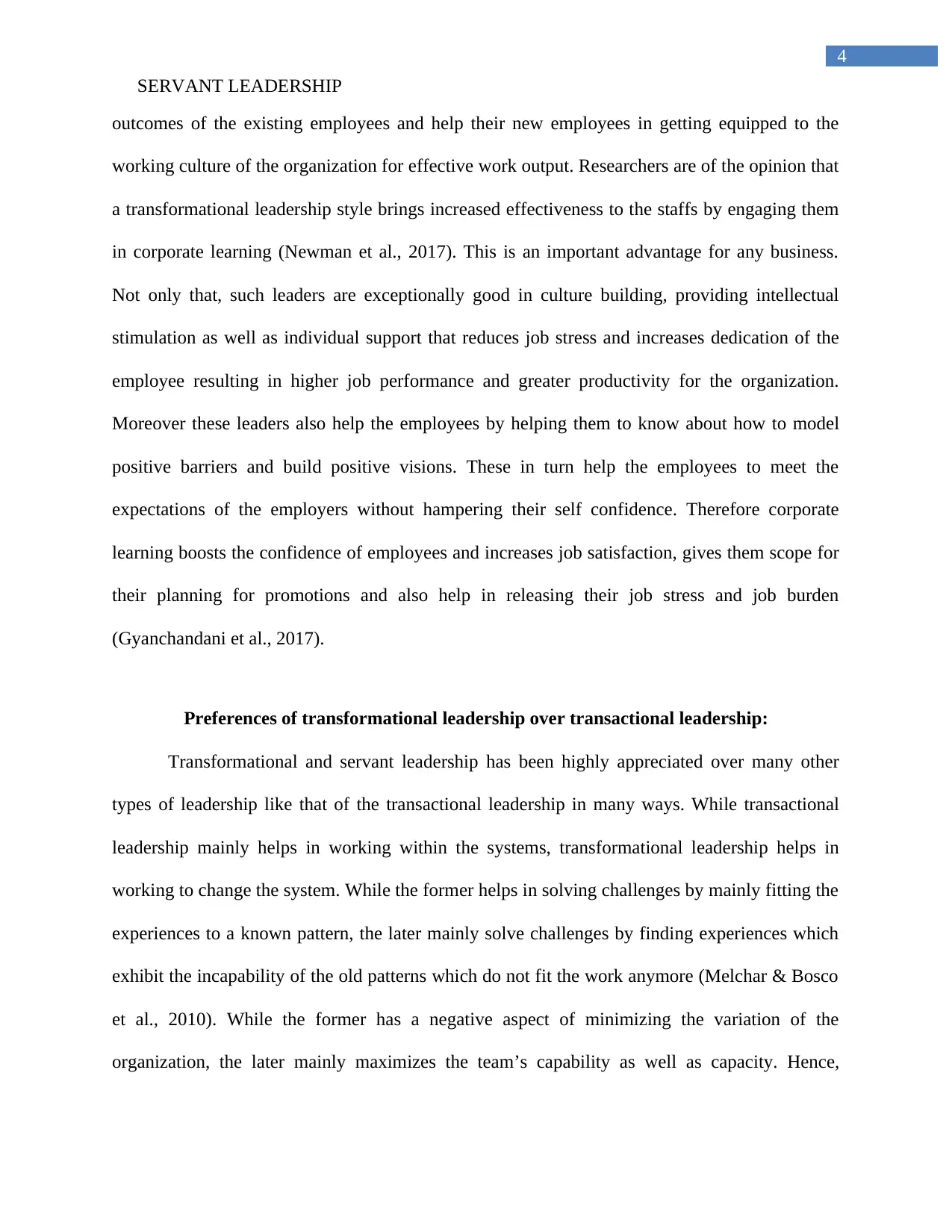
4
SERVANT LEADERSHIP
outcomes of the existing employees and help their new employees in getting equipped to the
working culture of the organization for effective work output. Researchers are of the opinion that
a transformational leadership style brings increased effectiveness to the staffs by engaging them
in corporate learning (Newman et al., 2017). This is an important advantage for any business.
Not only that, such leaders are exceptionally good in culture building, providing intellectual
stimulation as well as individual support that reduces job stress and increases dedication of the
employee resulting in higher job performance and greater productivity for the organization.
Moreover these leaders also help the employees by helping them to know about how to model
positive barriers and build positive visions. These in turn help the employees to meet the
expectations of the employers without hampering their self confidence. Therefore corporate
learning boosts the confidence of employees and increases job satisfaction, gives them scope for
their planning for promotions and also help in releasing their job stress and job burden
(Gyanchandani et al., 2017).
Preferences of transformational leadership over transactional leadership:
Transformational and servant leadership has been highly appreciated over many other
types of leadership like that of the transactional leadership in many ways. While transactional
leadership mainly helps in working within the systems, transformational leadership helps in
working to change the system. While the former helps in solving challenges by mainly fitting the
experiences to a known pattern, the later mainly solve challenges by finding experiences which
exhibit the incapability of the old patterns which do not fit the work anymore (Melchar & Bosco
et al., 2010). While the former has a negative aspect of minimizing the variation of the
organization, the later mainly maximizes the team’s capability as well as capacity. Hence,
SERVANT LEADERSHIP
outcomes of the existing employees and help their new employees in getting equipped to the
working culture of the organization for effective work output. Researchers are of the opinion that
a transformational leadership style brings increased effectiveness to the staffs by engaging them
in corporate learning (Newman et al., 2017). This is an important advantage for any business.
Not only that, such leaders are exceptionally good in culture building, providing intellectual
stimulation as well as individual support that reduces job stress and increases dedication of the
employee resulting in higher job performance and greater productivity for the organization.
Moreover these leaders also help the employees by helping them to know about how to model
positive barriers and build positive visions. These in turn help the employees to meet the
expectations of the employers without hampering their self confidence. Therefore corporate
learning boosts the confidence of employees and increases job satisfaction, gives them scope for
their planning for promotions and also help in releasing their job stress and job burden
(Gyanchandani et al., 2017).
Preferences of transformational leadership over transactional leadership:
Transformational and servant leadership has been highly appreciated over many other
types of leadership like that of the transactional leadership in many ways. While transactional
leadership mainly helps in working within the systems, transformational leadership helps in
working to change the system. While the former helps in solving challenges by mainly fitting the
experiences to a known pattern, the later mainly solve challenges by finding experiences which
exhibit the incapability of the old patterns which do not fit the work anymore (Melchar & Bosco
et al., 2010). While the former has a negative aspect of minimizing the variation of the
organization, the later mainly maximizes the team’s capability as well as capacity. Hence,
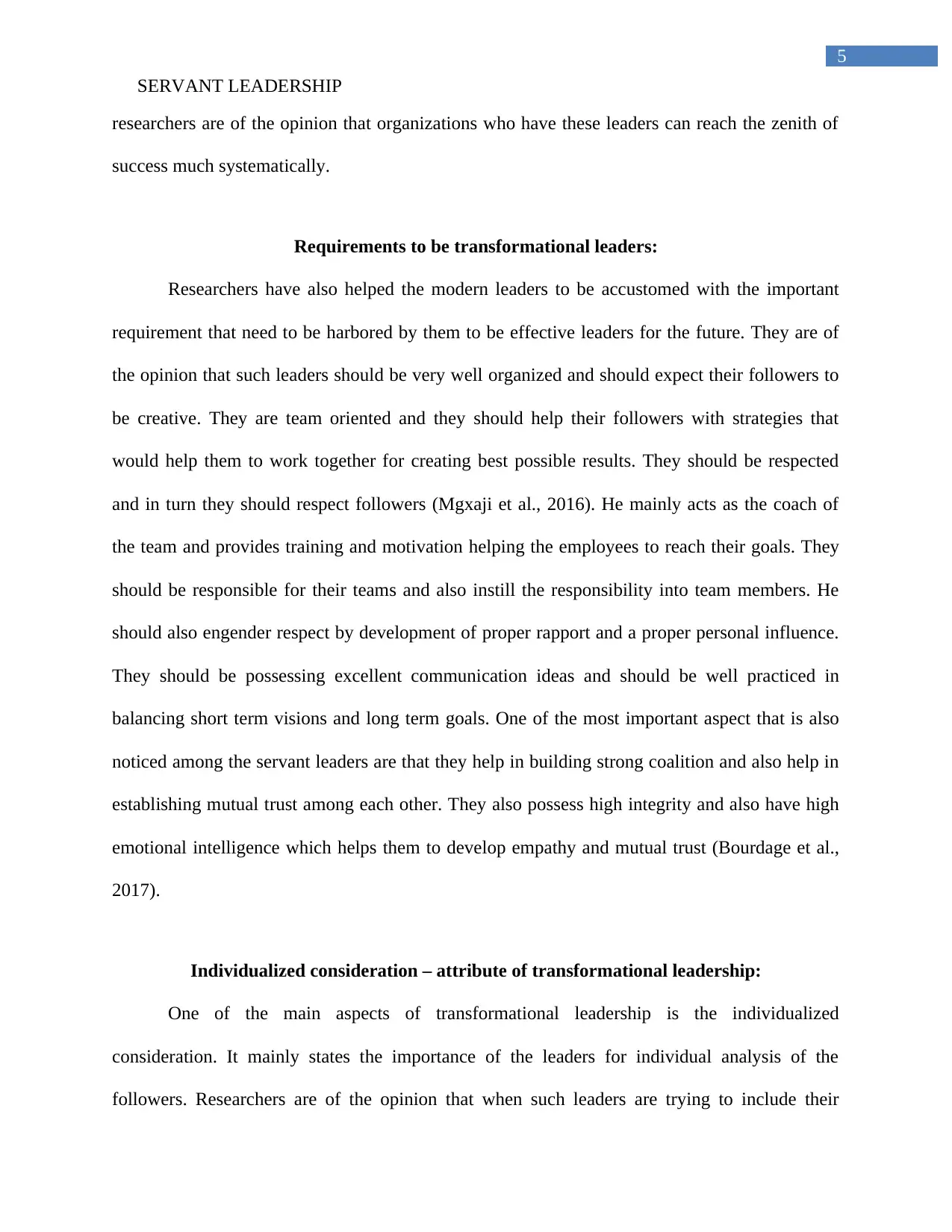
5
SERVANT LEADERSHIP
researchers are of the opinion that organizations who have these leaders can reach the zenith of
success much systematically.
Requirements to be transformational leaders:
Researchers have also helped the modern leaders to be accustomed with the important
requirement that need to be harbored by them to be effective leaders for the future. They are of
the opinion that such leaders should be very well organized and should expect their followers to
be creative. They are team oriented and they should help their followers with strategies that
would help them to work together for creating best possible results. They should be respected
and in turn they should respect followers (Mgxaji et al., 2016). He mainly acts as the coach of
the team and provides training and motivation helping the employees to reach their goals. They
should be responsible for their teams and also instill the responsibility into team members. He
should also engender respect by development of proper rapport and a proper personal influence.
They should be possessing excellent communication ideas and should be well practiced in
balancing short term visions and long term goals. One of the most important aspect that is also
noticed among the servant leaders are that they help in building strong coalition and also help in
establishing mutual trust among each other. They also possess high integrity and also have high
emotional intelligence which helps them to develop empathy and mutual trust (Bourdage et al.,
2017).
Individualized consideration – attribute of transformational leadership:
One of the main aspects of transformational leadership is the individualized
consideration. It mainly states the importance of the leaders for individual analysis of the
followers. Researchers are of the opinion that when such leaders are trying to include their
SERVANT LEADERSHIP
researchers are of the opinion that organizations who have these leaders can reach the zenith of
success much systematically.
Requirements to be transformational leaders:
Researchers have also helped the modern leaders to be accustomed with the important
requirement that need to be harbored by them to be effective leaders for the future. They are of
the opinion that such leaders should be very well organized and should expect their followers to
be creative. They are team oriented and they should help their followers with strategies that
would help them to work together for creating best possible results. They should be respected
and in turn they should respect followers (Mgxaji et al., 2016). He mainly acts as the coach of
the team and provides training and motivation helping the employees to reach their goals. They
should be responsible for their teams and also instill the responsibility into team members. He
should also engender respect by development of proper rapport and a proper personal influence.
They should be possessing excellent communication ideas and should be well practiced in
balancing short term visions and long term goals. One of the most important aspect that is also
noticed among the servant leaders are that they help in building strong coalition and also help in
establishing mutual trust among each other. They also possess high integrity and also have high
emotional intelligence which helps them to develop empathy and mutual trust (Bourdage et al.,
2017).
Individualized consideration – attribute of transformational leadership:
One of the main aspects of transformational leadership is the individualized
consideration. It mainly states the importance of the leaders for individual analysis of the
followers. Researchers are of the opinion that when such leaders are trying to include their
⊘ This is a preview!⊘
Do you want full access?
Subscribe today to unlock all pages.

Trusted by 1+ million students worldwide
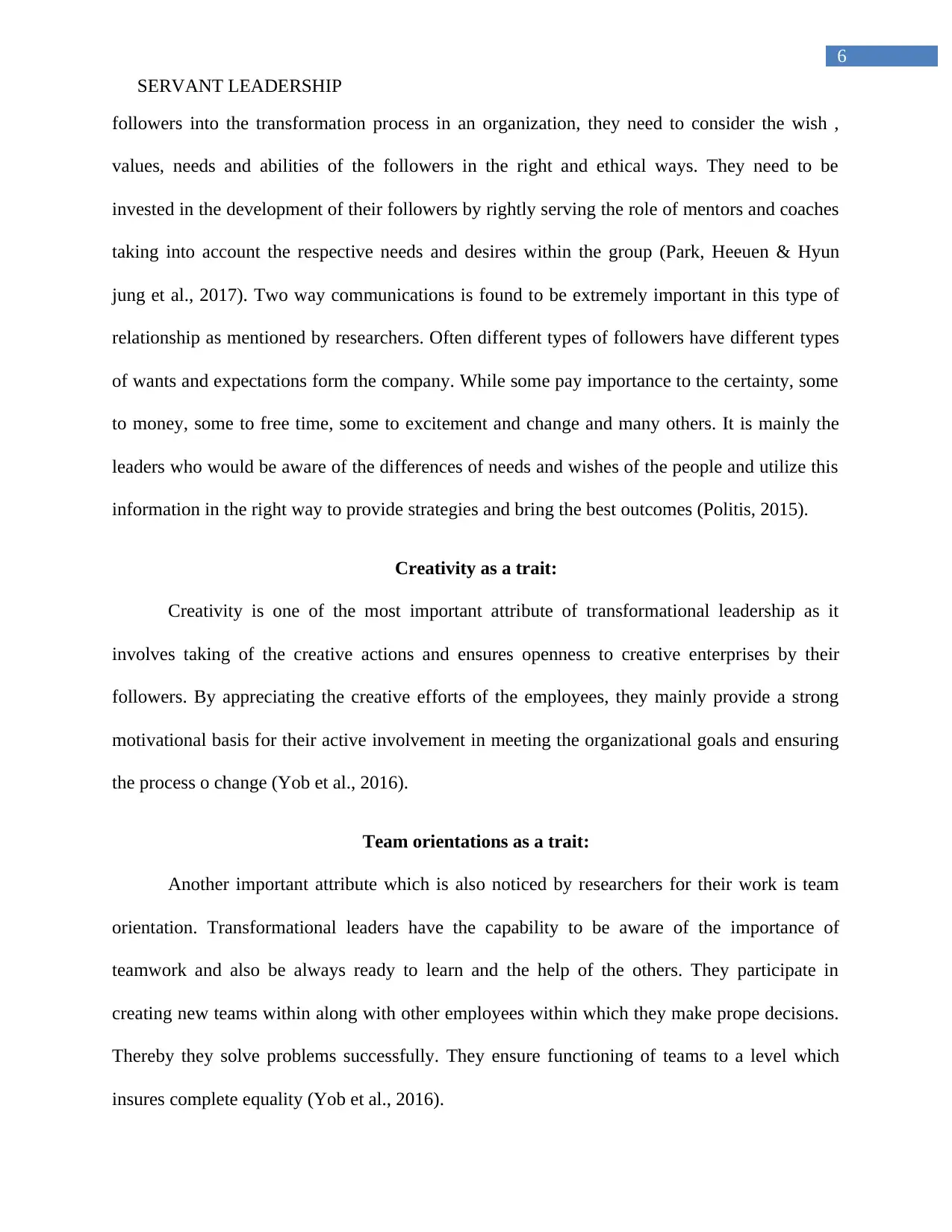
6
SERVANT LEADERSHIP
followers into the transformation process in an organization, they need to consider the wish ,
values, needs and abilities of the followers in the right and ethical ways. They need to be
invested in the development of their followers by rightly serving the role of mentors and coaches
taking into account the respective needs and desires within the group (Park, Heeuen & Hyun
jung et al., 2017). Two way communications is found to be extremely important in this type of
relationship as mentioned by researchers. Often different types of followers have different types
of wants and expectations form the company. While some pay importance to the certainty, some
to money, some to free time, some to excitement and change and many others. It is mainly the
leaders who would be aware of the differences of needs and wishes of the people and utilize this
information in the right way to provide strategies and bring the best outcomes (Politis, 2015).
Creativity as a trait:
Creativity is one of the most important attribute of transformational leadership as it
involves taking of the creative actions and ensures openness to creative enterprises by their
followers. By appreciating the creative efforts of the employees, they mainly provide a strong
motivational basis for their active involvement in meeting the organizational goals and ensuring
the process o change (Yob et al., 2016).
Team orientations as a trait:
Another important attribute which is also noticed by researchers for their work is team
orientation. Transformational leaders have the capability to be aware of the importance of
teamwork and also be always ready to learn and the help of the others. They participate in
creating new teams within along with other employees within which they make prope decisions.
Thereby they solve problems successfully. They ensure functioning of teams to a level which
insures complete equality (Yob et al., 2016).
SERVANT LEADERSHIP
followers into the transformation process in an organization, they need to consider the wish ,
values, needs and abilities of the followers in the right and ethical ways. They need to be
invested in the development of their followers by rightly serving the role of mentors and coaches
taking into account the respective needs and desires within the group (Park, Heeuen & Hyun
jung et al., 2017). Two way communications is found to be extremely important in this type of
relationship as mentioned by researchers. Often different types of followers have different types
of wants and expectations form the company. While some pay importance to the certainty, some
to money, some to free time, some to excitement and change and many others. It is mainly the
leaders who would be aware of the differences of needs and wishes of the people and utilize this
information in the right way to provide strategies and bring the best outcomes (Politis, 2015).
Creativity as a trait:
Creativity is one of the most important attribute of transformational leadership as it
involves taking of the creative actions and ensures openness to creative enterprises by their
followers. By appreciating the creative efforts of the employees, they mainly provide a strong
motivational basis for their active involvement in meeting the organizational goals and ensuring
the process o change (Yob et al., 2016).
Team orientations as a trait:
Another important attribute which is also noticed by researchers for their work is team
orientation. Transformational leaders have the capability to be aware of the importance of
teamwork and also be always ready to learn and the help of the others. They participate in
creating new teams within along with other employees within which they make prope decisions.
Thereby they solve problems successfully. They ensure functioning of teams to a level which
insures complete equality (Yob et al., 2016).
Paraphrase This Document
Need a fresh take? Get an instant paraphrase of this document with our AI Paraphraser
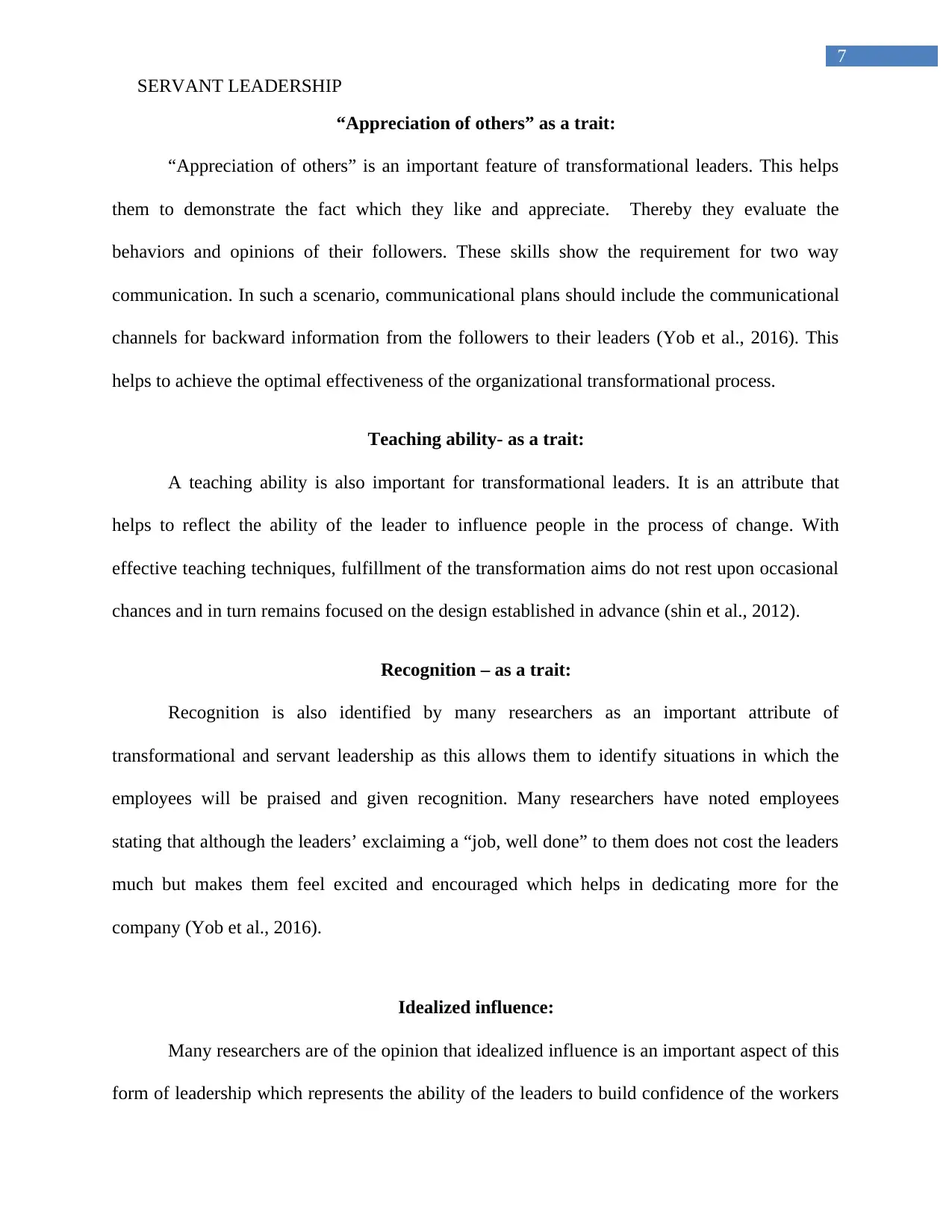
7
SERVANT LEADERSHIP
“Appreciation of others” as a trait:
“Appreciation of others” is an important feature of transformational leaders. This helps
them to demonstrate the fact which they like and appreciate. Thereby they evaluate the
behaviors and opinions of their followers. These skills show the requirement for two way
communication. In such a scenario, communicational plans should include the communicational
channels for backward information from the followers to their leaders (Yob et al., 2016). This
helps to achieve the optimal effectiveness of the organizational transformational process.
Teaching ability- as a trait:
A teaching ability is also important for transformational leaders. It is an attribute that
helps to reflect the ability of the leader to influence people in the process of change. With
effective teaching techniques, fulfillment of the transformation aims do not rest upon occasional
chances and in turn remains focused on the design established in advance (shin et al., 2012).
Recognition – as a trait:
Recognition is also identified by many researchers as an important attribute of
transformational and servant leadership as this allows them to identify situations in which the
employees will be praised and given recognition. Many researchers have noted employees
stating that although the leaders’ exclaiming a “job, well done” to them does not cost the leaders
much but makes them feel excited and encouraged which helps in dedicating more for the
company (Yob et al., 2016).
Idealized influence:
Many researchers are of the opinion that idealized influence is an important aspect of this
form of leadership which represents the ability of the leaders to build confidence of the workers
SERVANT LEADERSHIP
“Appreciation of others” as a trait:
“Appreciation of others” is an important feature of transformational leaders. This helps
them to demonstrate the fact which they like and appreciate. Thereby they evaluate the
behaviors and opinions of their followers. These skills show the requirement for two way
communication. In such a scenario, communicational plans should include the communicational
channels for backward information from the followers to their leaders (Yob et al., 2016). This
helps to achieve the optimal effectiveness of the organizational transformational process.
Teaching ability- as a trait:
A teaching ability is also important for transformational leaders. It is an attribute that
helps to reflect the ability of the leader to influence people in the process of change. With
effective teaching techniques, fulfillment of the transformation aims do not rest upon occasional
chances and in turn remains focused on the design established in advance (shin et al., 2012).
Recognition – as a trait:
Recognition is also identified by many researchers as an important attribute of
transformational and servant leadership as this allows them to identify situations in which the
employees will be praised and given recognition. Many researchers have noted employees
stating that although the leaders’ exclaiming a “job, well done” to them does not cost the leaders
much but makes them feel excited and encouraged which helps in dedicating more for the
company (Yob et al., 2016).
Idealized influence:
Many researchers are of the opinion that idealized influence is an important aspect of this
form of leadership which represents the ability of the leaders to build confidence of the workers
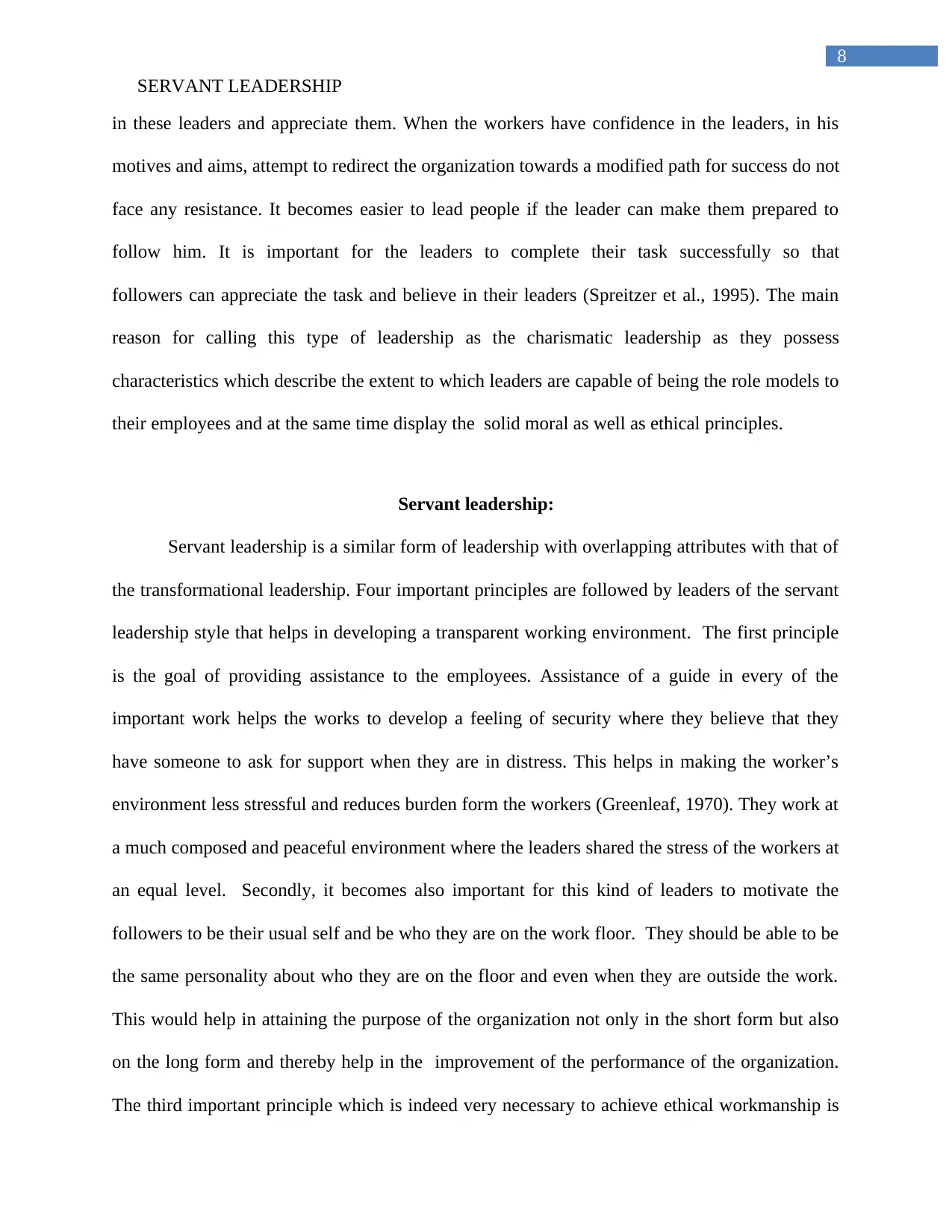
8
SERVANT LEADERSHIP
in these leaders and appreciate them. When the workers have confidence in the leaders, in his
motives and aims, attempt to redirect the organization towards a modified path for success do not
face any resistance. It becomes easier to lead people if the leader can make them prepared to
follow him. It is important for the leaders to complete their task successfully so that
followers can appreciate the task and believe in their leaders (Spreitzer et al., 1995). The main
reason for calling this type of leadership as the charismatic leadership as they possess
characteristics which describe the extent to which leaders are capable of being the role models to
their employees and at the same time display the solid moral as well as ethical principles.
Servant leadership:
Servant leadership is a similar form of leadership with overlapping attributes with that of
the transformational leadership. Four important principles are followed by leaders of the servant
leadership style that helps in developing a transparent working environment. The first principle
is the goal of providing assistance to the employees. Assistance of a guide in every of the
important work helps the works to develop a feeling of security where they believe that they
have someone to ask for support when they are in distress. This helps in making the worker’s
environment less stressful and reduces burden form the workers (Greenleaf, 1970). They work at
a much composed and peaceful environment where the leaders shared the stress of the workers at
an equal level. Secondly, it becomes also important for this kind of leaders to motivate the
followers to be their usual self and be who they are on the work floor. They should be able to be
the same personality about who they are on the floor and even when they are outside the work.
This would help in attaining the purpose of the organization not only in the short form but also
on the long form and thereby help in the improvement of the performance of the organization.
The third important principle which is indeed very necessary to achieve ethical workmanship is
SERVANT LEADERSHIP
in these leaders and appreciate them. When the workers have confidence in the leaders, in his
motives and aims, attempt to redirect the organization towards a modified path for success do not
face any resistance. It becomes easier to lead people if the leader can make them prepared to
follow him. It is important for the leaders to complete their task successfully so that
followers can appreciate the task and believe in their leaders (Spreitzer et al., 1995). The main
reason for calling this type of leadership as the charismatic leadership as they possess
characteristics which describe the extent to which leaders are capable of being the role models to
their employees and at the same time display the solid moral as well as ethical principles.
Servant leadership:
Servant leadership is a similar form of leadership with overlapping attributes with that of
the transformational leadership. Four important principles are followed by leaders of the servant
leadership style that helps in developing a transparent working environment. The first principle
is the goal of providing assistance to the employees. Assistance of a guide in every of the
important work helps the works to develop a feeling of security where they believe that they
have someone to ask for support when they are in distress. This helps in making the worker’s
environment less stressful and reduces burden form the workers (Greenleaf, 1970). They work at
a much composed and peaceful environment where the leaders shared the stress of the workers at
an equal level. Secondly, it becomes also important for this kind of leaders to motivate the
followers to be their usual self and be who they are on the work floor. They should be able to be
the same personality about who they are on the floor and even when they are outside the work.
This would help in attaining the purpose of the organization not only in the short form but also
on the long form and thereby help in the improvement of the performance of the organization.
The third important principle which is indeed very necessary to achieve ethical workmanship is
⊘ This is a preview!⊘
Do you want full access?
Subscribe today to unlock all pages.

Trusted by 1+ million students worldwide
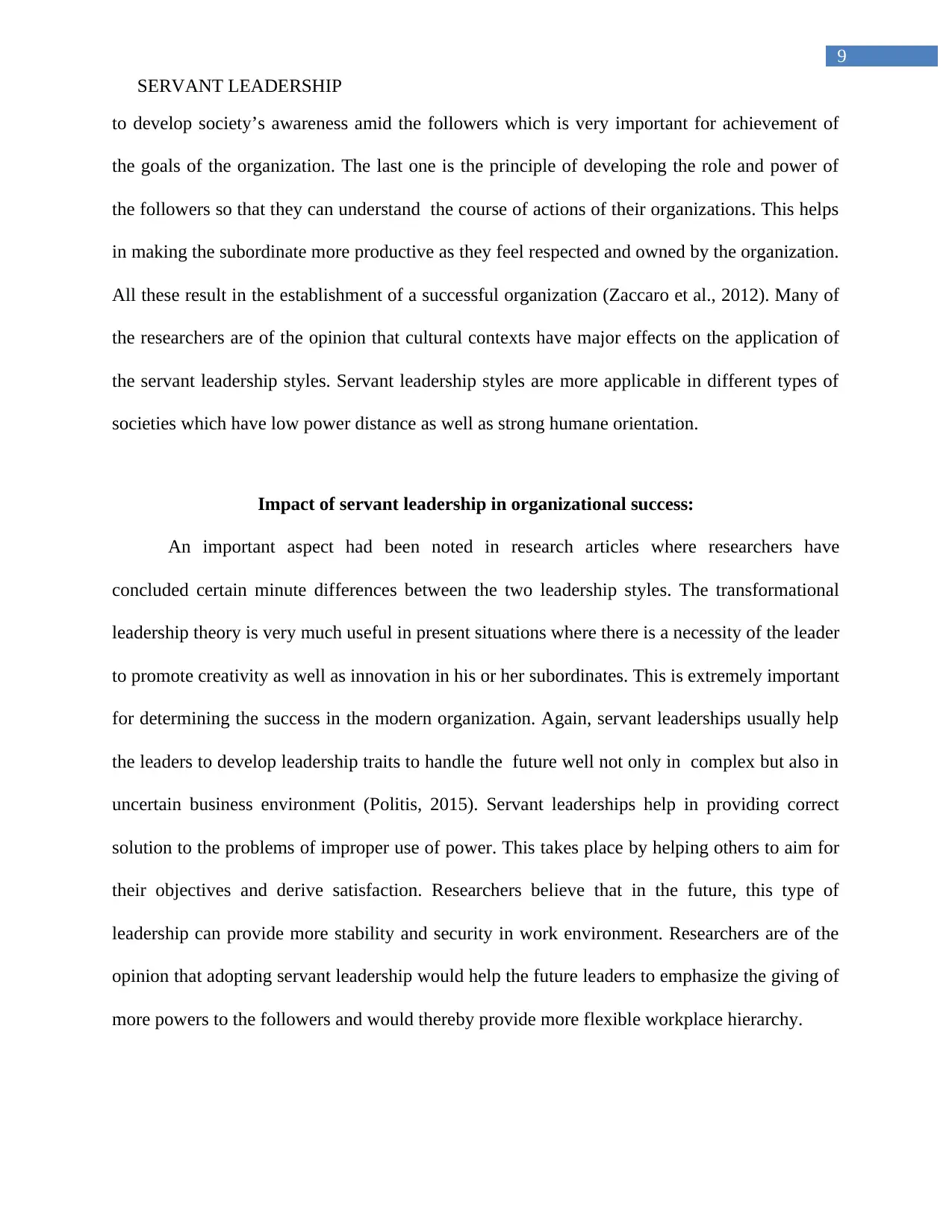
9
SERVANT LEADERSHIP
to develop society’s awareness amid the followers which is very important for achievement of
the goals of the organization. The last one is the principle of developing the role and power of
the followers so that they can understand the course of actions of their organizations. This helps
in making the subordinate more productive as they feel respected and owned by the organization.
All these result in the establishment of a successful organization (Zaccaro et al., 2012). Many of
the researchers are of the opinion that cultural contexts have major effects on the application of
the servant leadership styles. Servant leadership styles are more applicable in different types of
societies which have low power distance as well as strong humane orientation.
Impact of servant leadership in organizational success:
An important aspect had been noted in research articles where researchers have
concluded certain minute differences between the two leadership styles. The transformational
leadership theory is very much useful in present situations where there is a necessity of the leader
to promote creativity as well as innovation in his or her subordinates. This is extremely important
for determining the success in the modern organization. Again, servant leaderships usually help
the leaders to develop leadership traits to handle the future well not only in complex but also in
uncertain business environment (Politis, 2015). Servant leaderships help in providing correct
solution to the problems of improper use of power. This takes place by helping others to aim for
their objectives and derive satisfaction. Researchers believe that in the future, this type of
leadership can provide more stability and security in work environment. Researchers are of the
opinion that adopting servant leadership would help the future leaders to emphasize the giving of
more powers to the followers and would thereby provide more flexible workplace hierarchy.
SERVANT LEADERSHIP
to develop society’s awareness amid the followers which is very important for achievement of
the goals of the organization. The last one is the principle of developing the role and power of
the followers so that they can understand the course of actions of their organizations. This helps
in making the subordinate more productive as they feel respected and owned by the organization.
All these result in the establishment of a successful organization (Zaccaro et al., 2012). Many of
the researchers are of the opinion that cultural contexts have major effects on the application of
the servant leadership styles. Servant leadership styles are more applicable in different types of
societies which have low power distance as well as strong humane orientation.
Impact of servant leadership in organizational success:
An important aspect had been noted in research articles where researchers have
concluded certain minute differences between the two leadership styles. The transformational
leadership theory is very much useful in present situations where there is a necessity of the leader
to promote creativity as well as innovation in his or her subordinates. This is extremely important
for determining the success in the modern organization. Again, servant leaderships usually help
the leaders to develop leadership traits to handle the future well not only in complex but also in
uncertain business environment (Politis, 2015). Servant leaderships help in providing correct
solution to the problems of improper use of power. This takes place by helping others to aim for
their objectives and derive satisfaction. Researchers believe that in the future, this type of
leadership can provide more stability and security in work environment. Researchers are of the
opinion that adopting servant leadership would help the future leaders to emphasize the giving of
more powers to the followers and would thereby provide more flexible workplace hierarchy.
Paraphrase This Document
Need a fresh take? Get an instant paraphrase of this document with our AI Paraphraser
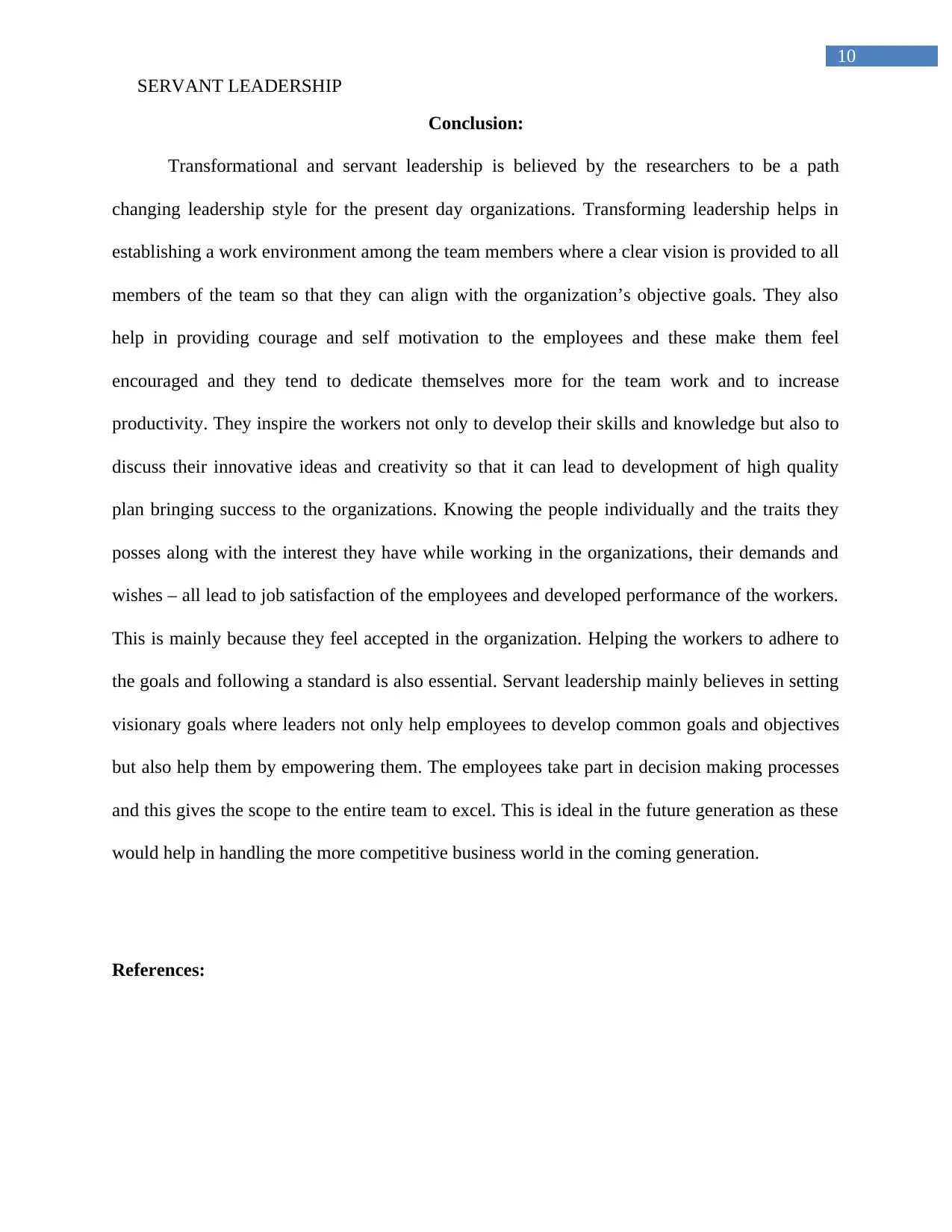
10
SERVANT LEADERSHIP
Conclusion:
Transformational and servant leadership is believed by the researchers to be a path
changing leadership style for the present day organizations. Transforming leadership helps in
establishing a work environment among the team members where a clear vision is provided to all
members of the team so that they can align with the organization’s objective goals. They also
help in providing courage and self motivation to the employees and these make them feel
encouraged and they tend to dedicate themselves more for the team work and to increase
productivity. They inspire the workers not only to develop their skills and knowledge but also to
discuss their innovative ideas and creativity so that it can lead to development of high quality
plan bringing success to the organizations. Knowing the people individually and the traits they
posses along with the interest they have while working in the organizations, their demands and
wishes – all lead to job satisfaction of the employees and developed performance of the workers.
This is mainly because they feel accepted in the organization. Helping the workers to adhere to
the goals and following a standard is also essential. Servant leadership mainly believes in setting
visionary goals where leaders not only help employees to develop common goals and objectives
but also help them by empowering them. The employees take part in decision making processes
and this gives the scope to the entire team to excel. This is ideal in the future generation as these
would help in handling the more competitive business world in the coming generation.
References:
SERVANT LEADERSHIP
Conclusion:
Transformational and servant leadership is believed by the researchers to be a path
changing leadership style for the present day organizations. Transforming leadership helps in
establishing a work environment among the team members where a clear vision is provided to all
members of the team so that they can align with the organization’s objective goals. They also
help in providing courage and self motivation to the employees and these make them feel
encouraged and they tend to dedicate themselves more for the team work and to increase
productivity. They inspire the workers not only to develop their skills and knowledge but also to
discuss their innovative ideas and creativity so that it can lead to development of high quality
plan bringing success to the organizations. Knowing the people individually and the traits they
posses along with the interest they have while working in the organizations, their demands and
wishes – all lead to job satisfaction of the employees and developed performance of the workers.
This is mainly because they feel accepted in the organization. Helping the workers to adhere to
the goals and following a standard is also essential. Servant leadership mainly believes in setting
visionary goals where leaders not only help employees to develop common goals and objectives
but also help them by empowering them. The employees take part in decision making processes
and this gives the scope to the entire team to excel. This is ideal in the future generation as these
would help in handling the more competitive business world in the coming generation.
References:
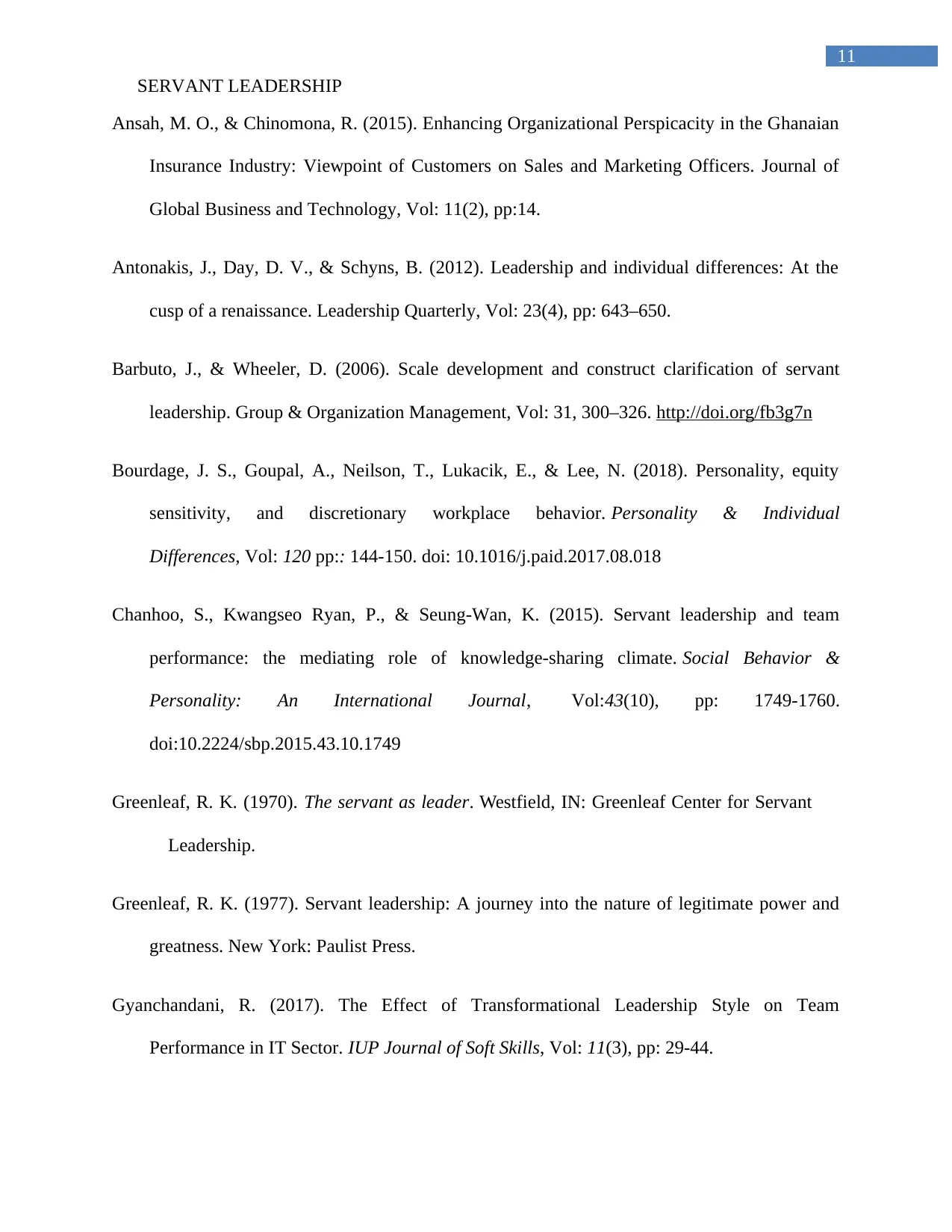
11
SERVANT LEADERSHIP
Ansah, M. O., & Chinomona, R. (2015). Enhancing Organizational Perspicacity in the Ghanaian
Insurance Industry: Viewpoint of Customers on Sales and Marketing Officers. Journal of
Global Business and Technology, Vol: 11(2), pp:14.
Antonakis, J., Day, D. V., & Schyns, B. (2012). Leadership and individual differences: At the
cusp of a renaissance. Leadership Quarterly, Vol: 23(4), pp: 643–650.
Barbuto, J., & Wheeler, D. (2006). Scale development and construct clarification of servant
leadership. Group & Organization Management, Vol: 31, 300–326. http://doi.org/fb3g7n
Bourdage, J. S., Goupal, A., Neilson, T., Lukacik, E., & Lee, N. (2018). Personality, equity
sensitivity, and discretionary workplace behavior. Personality & Individual
Differences, Vol: 120 pp:: 144-150. doi: 10.1016/j.paid.2017.08.018
Chanhoo, S., Kwangseo Ryan, P., & Seung-Wan, K. (2015). Servant leadership and team
performance: the mediating role of knowledge-sharing climate. Social Behavior &
Personality: An International Journal, Vol:43(10), pp: 1749-1760.
doi:10.2224/sbp.2015.43.10.1749
Greenleaf, R. K. (1970). The servant as leader. Westfield, IN: Greenleaf Center for Servant
Leadership.
Greenleaf, R. K. (1977). Servant leadership: A journey into the nature of legitimate power and
greatness. New York: Paulist Press.
Gyanchandani, R. (2017). The Effect of Transformational Leadership Style on Team
Performance in IT Sector. IUP Journal of Soft Skills, Vol: 11(3), pp: 29-44.
SERVANT LEADERSHIP
Ansah, M. O., & Chinomona, R. (2015). Enhancing Organizational Perspicacity in the Ghanaian
Insurance Industry: Viewpoint of Customers on Sales and Marketing Officers. Journal of
Global Business and Technology, Vol: 11(2), pp:14.
Antonakis, J., Day, D. V., & Schyns, B. (2012). Leadership and individual differences: At the
cusp of a renaissance. Leadership Quarterly, Vol: 23(4), pp: 643–650.
Barbuto, J., & Wheeler, D. (2006). Scale development and construct clarification of servant
leadership. Group & Organization Management, Vol: 31, 300–326. http://doi.org/fb3g7n
Bourdage, J. S., Goupal, A., Neilson, T., Lukacik, E., & Lee, N. (2018). Personality, equity
sensitivity, and discretionary workplace behavior. Personality & Individual
Differences, Vol: 120 pp:: 144-150. doi: 10.1016/j.paid.2017.08.018
Chanhoo, S., Kwangseo Ryan, P., & Seung-Wan, K. (2015). Servant leadership and team
performance: the mediating role of knowledge-sharing climate. Social Behavior &
Personality: An International Journal, Vol:43(10), pp: 1749-1760.
doi:10.2224/sbp.2015.43.10.1749
Greenleaf, R. K. (1970). The servant as leader. Westfield, IN: Greenleaf Center for Servant
Leadership.
Greenleaf, R. K. (1977). Servant leadership: A journey into the nature of legitimate power and
greatness. New York: Paulist Press.
Gyanchandani, R. (2017). The Effect of Transformational Leadership Style on Team
Performance in IT Sector. IUP Journal of Soft Skills, Vol: 11(3), pp: 29-44.
⊘ This is a preview!⊘
Do you want full access?
Subscribe today to unlock all pages.

Trusted by 1+ million students worldwide
1 out of 14
Related Documents
Your All-in-One AI-Powered Toolkit for Academic Success.
+13062052269
info@desklib.com
Available 24*7 on WhatsApp / Email
![[object Object]](/_next/static/media/star-bottom.7253800d.svg)
Unlock your academic potential
Copyright © 2020–2025 A2Z Services. All Rights Reserved. Developed and managed by ZUCOL.




